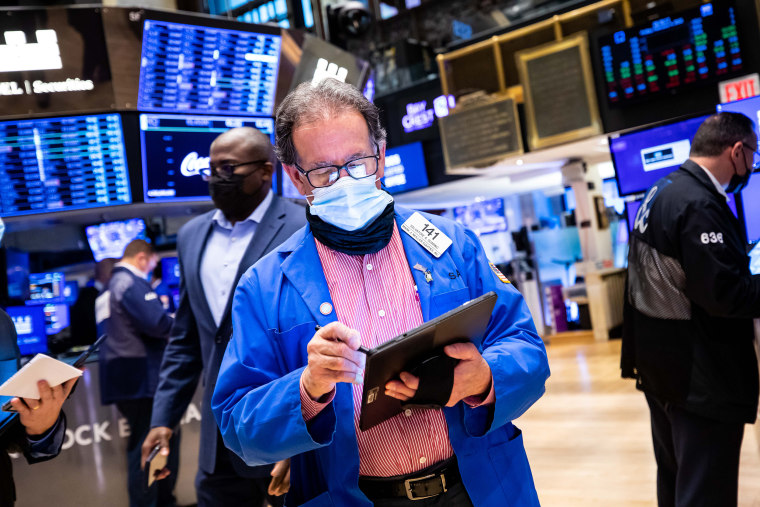The big bounce-back in the labor market that took place in January in spite of omicron bodes well for workers — but Wall Street is considerably less impressed. On the heels of a surprisingly robust jobs report that showed gains of 467,000 in January, markets slumped.
Economists say a strong labor market might be good for the economy, and a certain amount of wage inflation might benefit low-wage workers, but market participants worry that the transition away from ultra-loose monetary policy could be faster and bumpier than expected — factors that drive down stocks. The benchmark Dow Jones Industrial Average was down by about 100 points at midday, while a positive quarterly earnings report from Amazon helped to mitigate a similar slide in the tech-heavy Nasdaq.
“I think there could be a little bit of that ‘bad news is good news’ just based on the expected path of Fed tightening this year,” said Mark Heppenstall, president and chief investment officer at Penn Mutual Asset Management.
With inflation running at 40-year highs, the market expectations for a Fed that hikes rates numerous times — and perhaps in larger increments — has jolted stocks and agitated market volatility for the past several weeks as traders digest the potential for curtailed economic growth and the implications of higher borrowing costs on companies dependent on cheap money to expand.
“The market is more concerned about the outlook for inflation than the outlook for growth at this point, especially given the intense focus on Fed policy,” said Zachary Hill, head of portfolio management at Horizon Investments.
Before the jobs report was released, the CME FedWatch Tool showed a 13 percent probability of a half-percentage-point rate hike in March. Three hours later, that had risen by 20 percentage points.
“Clearly, there’s been a lot of volatility,” Heppenstall said. “It does seem as though the markets are pricing in a very aggressive Fed for the remainder of the year.” Conversely, a bleak job market would suggest to Wall Street that the Fed might tap the brakes on plans to tighten policy.
It does seem as though the markets are pricing in a very aggressive Fed for the remainder of the year.
That tension between Wall Street and Main Street is a challenge for policymakers trying to steer the economy into a new phase of post-pandemic normalcy.
“The jobs numbers that we got in the revisions blew away even the highest of expectations,” said Cliff Hodge, chief investment officer for Cornerstone Wealth. “If you take the headline numbers and also the increase in the labor force participation rate, these are certainly all very positive factors for the economy, but for the market, the reaction makes sense if you look at it through the lens of how the Fed may react,” he said.
In addition to the strong monthly numbers, annual revisions also showed that job growth throughout 2021 was both less volatile and more robust than the initial survey results had indicated. The total number of jobs created was revised up by 684,000 to 7.1 million, bringing the average monthly gain to 555,000.
“You’re seeing a lot of strength in labor, you’re seeing really hot wages, which portends inflation down the line. This gives the Fed cover to be more aggressive,” Hodge said.
What this report emphasized is we had a steady flow of workers back into the labor force, despite concerns about labor shortages.
It is still a buyer’s market for workers, experts said, and there is growing evidence that more people are being drawn back into the workforce on the strength of a reopening economy and higher pay. The labor force participation rate, which had been mired at around 61.9 percent, rose to 62.2 percent in January — a significant increase.
“The increase that we’re seeing is mostly due to the revision, but the silver lining is that labor force participation has been stronger than we initially realized. That indicates that workers are returning to the labor force and finding jobs,” said Daniel Zhao, senior economist at Glassdoor.
The aggregate labor market is still down by 2.9 million jobs since before the pandemic, but employment in a handful of sectors — most notably, transportation, warehousing and retail — has actually risen above February 2020 levels.
“What this report emphasized is we had a steady flow of workers back into the labor force despite concerns about labor shortages,” Zhao said.
Rapidly rising pay is one big part of that. In a January survey of nearly 400 companies, consulting firm Gallagher found that 15 percent of employers reported that they had increased compensation by 10 percent or more over the past six months to battle shortages of workers. The government data showed a year-over-year increase of 5.7 percent across all sectors.
“Inflation can often be one of the great equalizers in the economy,” said Robert Cantwell, portfolio manager at Upholdings. “It can raise wages for millions of folks all at the same time… Whether or not we achieve that this year will remain to be seen.”
But inflation also threatens to erode those wage gains. Leisure and hospitality is also the only sector for which wage gains are keeping ahead of inflation, with a 13 percent jump.
“If you think about it politically, wealth inequality has been a huge issue. With the Biden administration and the Democrats in power, they want the inequality to come down, and so there’s a lot of pressure politically to raise wages,” Hodge said.
Policymakers at the Federal Reserve will likely keep their focus on reining in rising prices — even if that triggers a tantrum on Wall Street, Hodge said.
“They will proceed with their plan on hiking, on balance sheet normalization… to support Main Street at the expense of the markets. I think investors need to be prepared for more volatility,” Hodge said.
